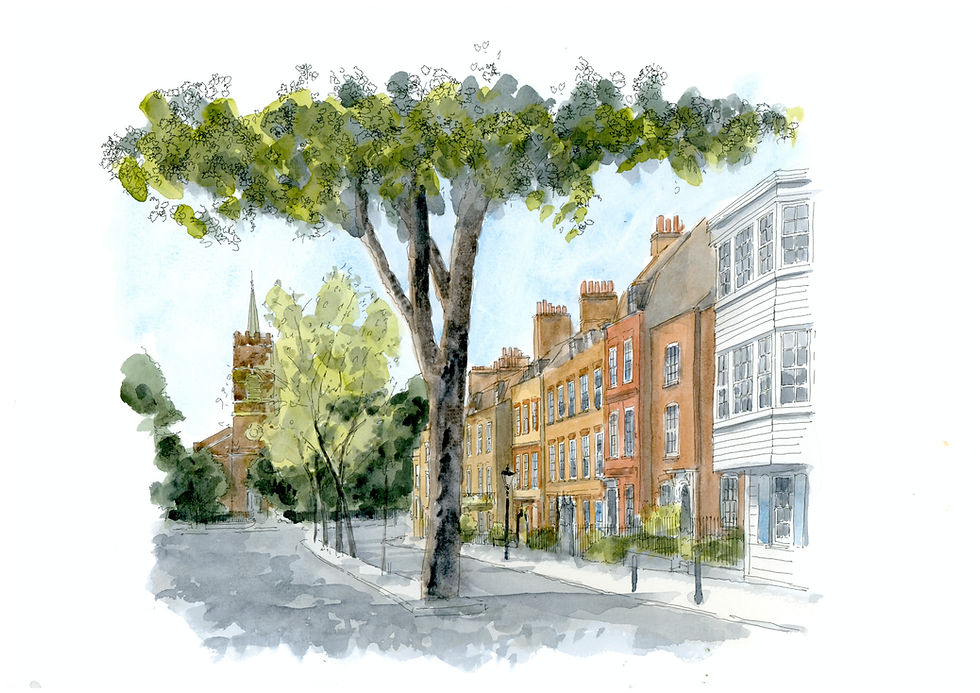Hampstead walk: Stop 5 Peter Pan and Captain Hook
- Christian

- Jan 17
- 3 min read
The finest Georgian street in London with a hint of Disney magic. It's the final resting place of the boy who never grew up, read on!

Walk from the High Street down Perrin's Court and you will see the old Victorian gas light. The light marks the entrance to Church Row one of the most picturesque and historically significant streets in this charming and affluent area of North London. Pevsner Architectural Guides, described Church Row as "the best street in Hampstead" and with good reason.
The street is lined with simple, well proportioned Georgian terraces, each with its own character. In the middle is the 'row' of Lime trees, many of these are later additions but their canopies do enclose the street well and give a feeling of being in a room. It's all quite romantic and explains why it has featured in so many romantic films; Notting Hill, Bridget Jones and even Love Actually. A few serious ones as well include Alfred Hitchcock's 1950 film Stage Fright and 2007's Atonement
At the end of the Street lies the St. John-at-Hampstead Church looking over its graveyard.

A church has stood on this site since 1333, but the current building mainly dates from 1843, when the previous structure was extended. The church was rededicated from St. Mary to St. John, but Mary should not worry; there is another St. Mary's up the road.
The church is Grade I listed and contains notable burials, including John Constable, the renowned landscape painter, and Jack and Peter Llewelyn Davies, who inspired the character of Peter Pan. Interestingly, the grave next door belongs to their uncle, Gerald du Maurier, who was the first actor to portray Captain Hook.
Peter Llewelyn Davies was one of the five Llewelyn Davies boys who inspired J.M. Barrie's creation of Peter Pan. Born on February 25, 1897, he was the middle child of Arthur and Sylvia Llewelyn Davies. Barrie publicly identified Peter as the source of the name for the title character in his 1904 play "Peter Pan, or The Boy Who Wouldn't Grow Up".The connection between Peter Llewelyn Davies and Peter Pan was complex and often troubled. While Barrie used Peter's name for the character, it was actually Peter's brother Michael who served as the primary inspiration for Peter Pan's boyish nature. Peter himself struggled with the association throughout his life, referring to the work as "that terrible masterpiece". Sadly Peter ended his life by suicide on April 5, 1960, at the age of 63.
Another intriguing legend associated with the graveyard is its connection to Bram Stoker's "Dracula." It's believed that the cemetery inspired Stoker when writing a pivotal scene in his novel. In the story, the vampire Lucy Westenra rises from her grave at night, adding a chilling supernatural element to the already eerie atmosphere of the graveyard.
It's unsurprising that such a lovey street as Church Row has had its fair share of famous residents.
Henry Cavendish lived at the end of Church Row by St. John's church during the 1780s. Lucky Cavendish also had a town residence in Great Marlborough Street. He calculated that the solar time difference between his two houses was exactly 10.2 seconds. It must be nice to have two homes in London particularly 10.2 seconds apart!
No 17 has had a few famous people through its doors. The writer H. G. Wells lived there with his wife, Jane, and two sons, George "Gip" Philip and Frank Richard, until 1912. The comedian Peter Cook bought it in 1965 and for 10 years it was a bit of a party house.Cook's wife, Wendy, would prepare dinner parties that would attract many notable people of the 1960s including John Bird, Eleanor Bron, John Cleese, Michael Foot, Bernard Levin, Victor Lownes, Malcolm Muggeridge, Charlotte Rampling, Willie Rushton, Peter Sellers, Cat Stevens, Ken Tynan and Peter Ustinov. Frequent visitors to Cook at the house included Johnand Cynthia Lennon and Paul McCartney. Lennon and Cook would perform comedy routines and characters at the dinner table. Nicholas Luard recalled a dinner party with an eclectic mix of guests including the actors Tom Courtney, and Peter O'Toole, the poet Christopher Logue, fashion designer Mary Quant and the boxer Terry Downes.
Sylvia Plath lived nearby and often strolled down the street, something I suggest everyone try.




Comments